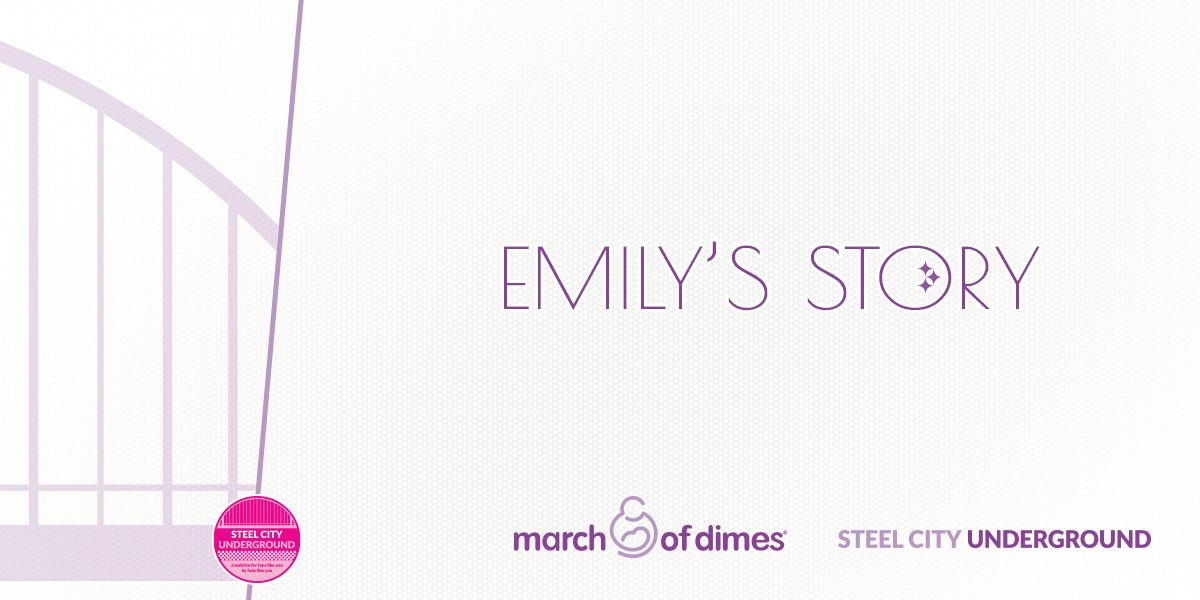Emily’s story sparks Steel City Underground March of Dimes fundraising contest
Nation, there is one time a year when all-things Black and Gold become the second-most important thing in my life that is not family. Normally, my priorities are family first, then Steelers.
But now is that time, where something else becomes more important. Let me tell you a little story, and that will help you to understand why my Black and Gold glasses suddenly get tinted slightly lavender for a few months.
In November of 2000, my daughter Emily was born. Emily was premature, arriving at only 25 weeks, and when she was born, weighing only 14.7 oz. (Yes, that’s right, less than 1 lb.). From the first moment that the doctors began to tell us that Emily would be arriving well before her expected due date, they told us that the chances of her surviving were very bad. Quite often they told us flat out that she would not make it.
- They said she was too small.
- They said she was too early.
- They told us repeatedly to expect the worst.
- They told us “Don’t hope.”
When my wife was wheeled into the operating room to have an emergency C-section, they told us:
- Her lungs would be too under-developed, and she wouldn’t make a sound.
- They said she probably wouldn’t even be able to breathe yet.
- They told us that in all likelihood, she wouldn’t survive the birth.
As I sat in the operating room with my wife, the doctors took Emily out of her, and suddenly we heard a sound.
“Waa… eh”
I said “What was that? Was that Emily?”
The nurse, mouth agape, shocked eyes above her surgical mask replied: “Oh my god! She’s trying to cry!”
At that moment I knew that it didn’t matter what the doctors or the experts had to say. I knew at that moment that this child was going to prove them all wrong. This child, all red and wriggly and covered in weird little orange hairs. This child who they said “couldn’t cry”, who they said probably “couldn’t breathe” was crying, and breathing.
She was given an APGAR score of 9; the APGAR score is a simple assessment of how a baby is doing at birth, which helps determine whether your newborn is ready to meet the world without additional medical assistance.
The best possible score is 10.
As triumphantly as she arrived, well, I’ll be honest: the great start didn’t last.
One week after she was born, she perforated her bowel, and the doctors again said “She won’t make it”. She had to be airlifted to another hospital where they had the facilities to operate on babies as small as she was. When we got there, they again said “She won’t survive this”.
But she did.
She made it through the procedure that essentially placed a drain right through the center of her body, and Emily just kept on fighting. Two weeks later, she developed a severe infection, and the doctors took us in a room and said “It’s time.”
They wanted us to let her go.
We said “No”.
Over the next 6 months, Emily battled through heart surgery, infections, broken limbs (both legs, and both arms), multiple transfusions and infections, laser eye surgery and 4 different hernia surgeries. She fought, and she struggled and she cried, and every time the doctors thought it was too much, she proved it wasn’t.
After 6 months, about 2 months after her originally expected due date, Emily came home.
To this day, I know in my heart that part of the reason Emily was capable of fighting the battles she fought had to do with two things.
First, before Emily was even born, Missy was given steroid injections to spur lung and organ growth in Emily.
Second, Emily was given surfactant, which is a treatment given to pre-mature babies to help protect their lungs. Emily spent months on a respirator, so she needed that protection.
There were other procedures and treatments that Emily received that helped her on her journey, and the one thing many of them have in common is this:
They were all discovered based on research that was sponsored or funded by the March of Dimes.
And just in case you don’t think the March of Dimes is a charity that has an impact on your life, ask yourself these questions:
- Were you, or someone you know born prematurely?
- Do you know anyone who has suffered a miscarriage or stillbirth?
- Do you know anyone born with a birth defect?
- Do you know a woman who has taken a prenatal vitamin?
- Did your child receive an APGAR score when they were born?
- Did your child get a heel prick test when they were born?
- Did you receive the Polio vaccine, or even better are you free from Polio?
(The March of Dimes first-stated mission was to wipe out polio, and guess what – they did!).
If you can answer “Yes” to any one of those question, then you my friend, are a March of Dimes baby.
The bottom line is that if you are here, and you know anyone with a child, or are quite simply free from polio, the March of Dimes has touched your life.
I know for sure it has touched mine.
The First Ever Annual Steel City Underground March of Dimes fundraising contest!
In case you were wondering… Emily is 16 now. She’s an honor student in High School, and a huge Steelers fan!
But it might not have ended this way without the March of Dimes. That’s why, every Spring for the past 15 years, I do whatever I can to help support the March of Dimes; primarily through fundraising based on their March for Babies walk, which this year takes place on April 30th.
I don’t mess around with this, and so, as I always do every year, I’m going to put my money (or in this case, my stuff) where my mouth is, and proudly announce: this contest.
For full details on how you can help, and official rules for entering the contest, visit the Steel City Underground March of Dimes fundraising contest page.
By donating to a great cause, you can help children like Emily while also giving yourself an opportunity to win an awesome prize.








